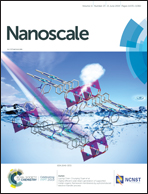Unusual plastic deformation behavior of nanotwinned Cu/high entropy alloy FeCoCrNi nanolaminates†
Abstract
Compared with coarse-grained FeCoCrNi-based high entropy alloys (HEAs), their nanocrystalline (NC) siblings with ultra-high strength often suffer from notably reduced deformability. Here, to enhance the deformability of these NC HEAs without losing their high strength, we design equal layered nanotwinned (NT) Cu/HEA (HEA = FeCoCrNi) crystalline/crystalline nanolaminates (C/CNLs) with coherent crystalline/crystalline interfaces (CCIs). In contrast to the tenet that in conventional bimetal C/CNLs, the soft/ductile phase plays the dominant major role, we discover that in NT Cu/HEA C/CNLs, the hard HEA phase unusually makes more contribution to the plastic deformation. The underlying reason is that the soft NT Cu layers without dislocation pile-up serve as the dislocation donator and export abundant dislocations that transmit across the coherent CCIs into the hard HEA accepter, and thus trigger their great deformability. The size-dependent hardness was explained based on dislocation-based models considering the stability of extremely small nanotwins with thickness less than ∼10 nm. These findings provide a new pathway to achieve great deformability of strong alloys with high lattice friction stresses in ultra-strong metallic composites: control the size of NT soft phases to suppress dislocation pile-up in conjunction with coherent CCIs to facilitate continuity of dislocation slip.



 Please wait while we load your content...
Please wait while we load your content...